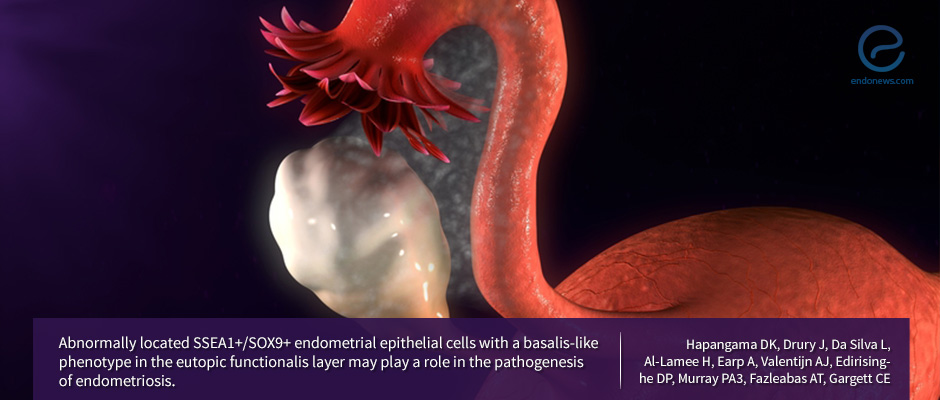Is the mystery for progression of endometriosis hiding out in abnormally located endometrial cells?
Jan 23, 2019
Women with endometriosis show profusely SSEA1 and nSOX9 basalis-like cells located in the functional layer of secretory phase eutopic endometrium.
Key Points
Highlights:
- More "basalis-like cells" are shed from the eutopic endometrium in women with endometriosis, during their menses.
Importance:
- Increased invitro activity of progenitor cells showing [SSE1(+)/SOX9(+)] signature, abundant in basalis region of eutopic endometrium has already notified.
- The differences in gene expression of basal-like cells SSEA1+ and eutopic endometrial cells from women with and without endometriosis to prove their hypothesis.
What's done here:
- Association between endometriosis and abnormally located basalis-like [SSE1(+)/SOX9(+)] cells were examined in endometrial samples of 102 women with or without endometriosis.
- Numbers and alterations of basalis-like [SSE1(+)/SOX9(+)] cells were evaluated in the eutopic endometrium of endometriosis-induced baboon model.
Key Results:
- In the functional layer of eutopic endometrium, higher numbers of basalis-like cells were found in endometriotic patients when compared to healthy women in their secretory phase.
- Same results have been found in eutopic baboon endometrium after induction of endometriosis.
- In women with endometriosis group isolated SSE1+ cells showed higher expression of OCT4, NANOG, FUT4 mRNA (p=0.05 p=0.07 p=0.018 respectively.
- In-vitro assays indicate samples of SSEA1 could derivated from women with endometriosis generated gland-line structures after 14 days of 3D culture.
Lay Summary
This prospective study was conducted by Hapangama et al. in Research İnstute of the University of Liverpool, UK, and the results have recently published in the Journal of Human Reproduction.
The authors hypothesized that abnormally located endometrial basalis-like (SSEA1/nSOX9+)cells could be contributing to ectopic endometriotic lesion formation, based on the previous findings of a higher number of "basalis-like cells" in eutopic endometrium of women with endometriosis, these cells have a [SSE1(+)/SOX9(+)] signature showed progenitor activity in-vitro, are also present in the ectopic endometrium. All these findings support the most commonly accepted endometriosis pathogenesis theory "retrograde menstruation"
To prove their hypothesis, the authors examined the presence and alterations of these cells in endometrial samples of 102 women with or without endometriosis by molecular technics, and the baboon model of endometriosis. When the eutopic endometria from women with endometriosis compared to the healthy control group, basalis epithelial cells SSEA1/nSOX9 were significantly higher in the functional layer of the secretory phase ectopic endometrium.
As a result, they exposed that samples of SSEA1+ cells taken women with endometriosis generated gland-like structures in-vitro 3D cultures which fortify their hypothesis.
Moreover, SSEA1 endometrial epithelial cells do not differentiate into mesodermal lineages in-vitro.
In conclusion, the authors are pleased with their results that showed a strong correlation with the retrograde menstrual flow theory of endometriosis pathogenesis.
Research Source: https://www.ncbi.nlm.nih.gov/pubmed/30496412
immunohistochemistry 3D culture SSEA1+ SOX9+ baboon model endometrial stem cells eutopic endometrium proliferation retrograd menstrual flow endometriosis.

